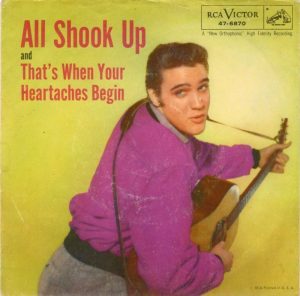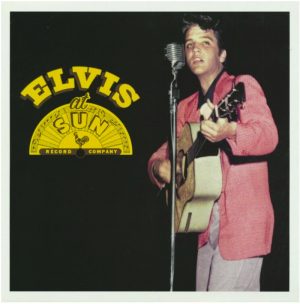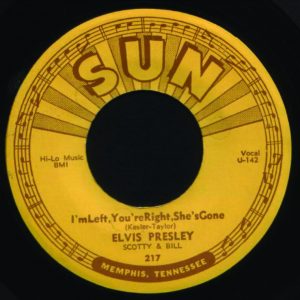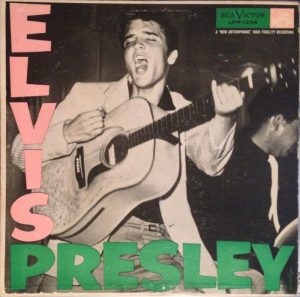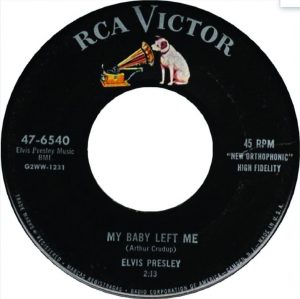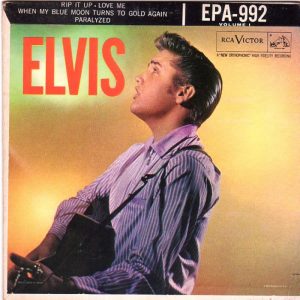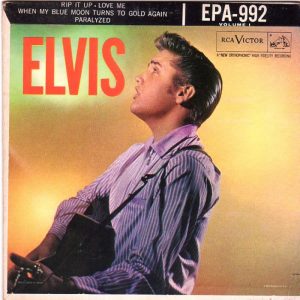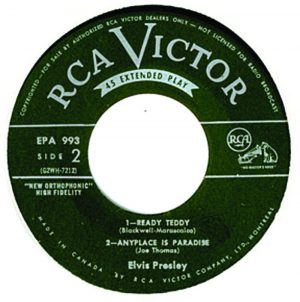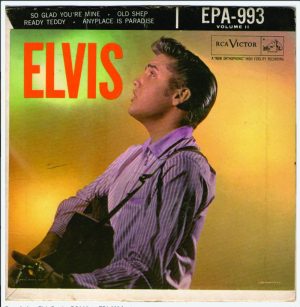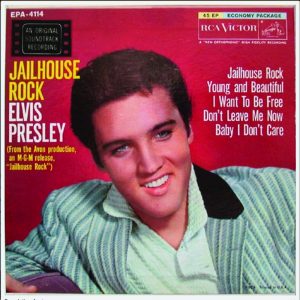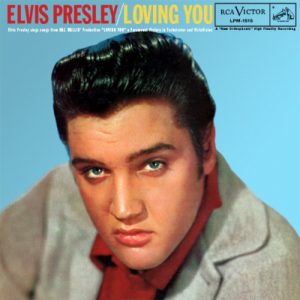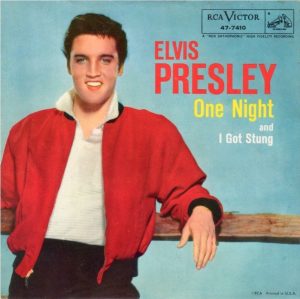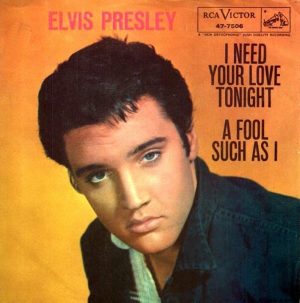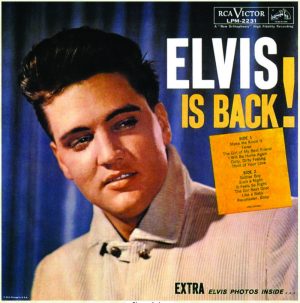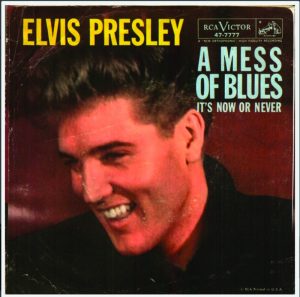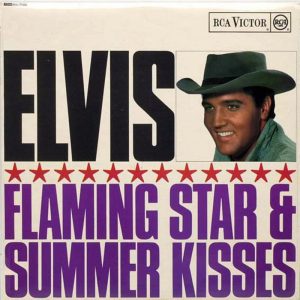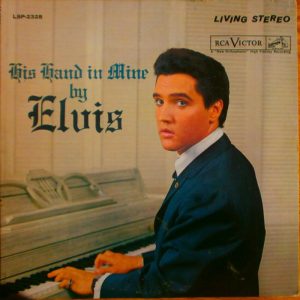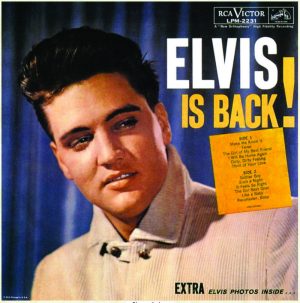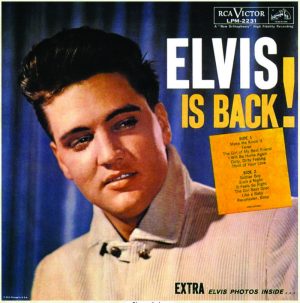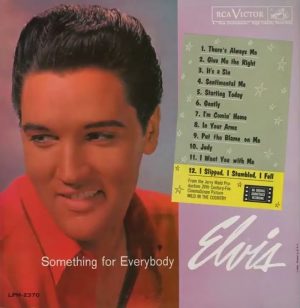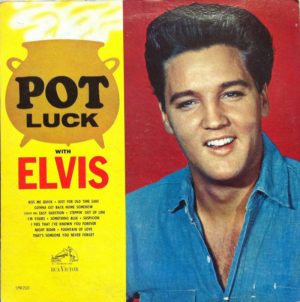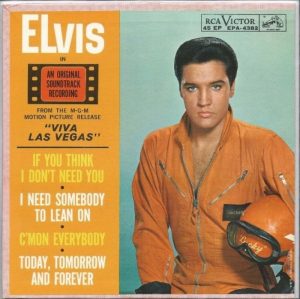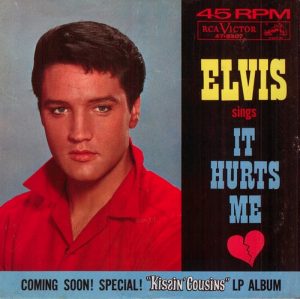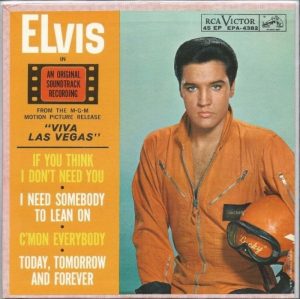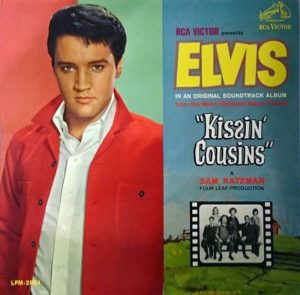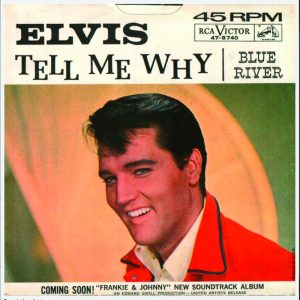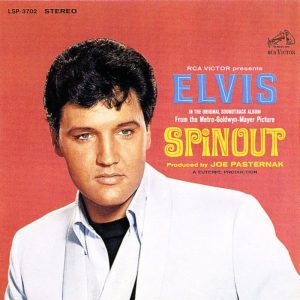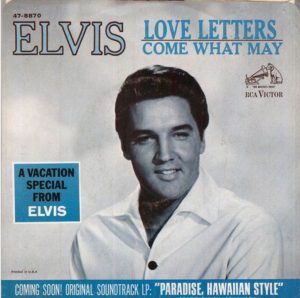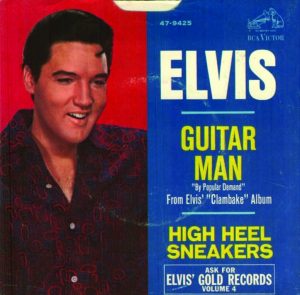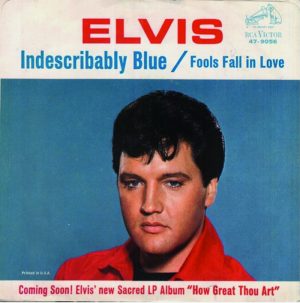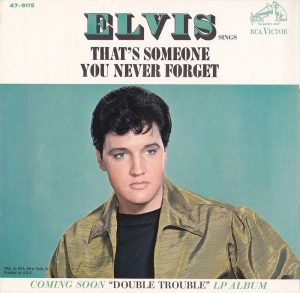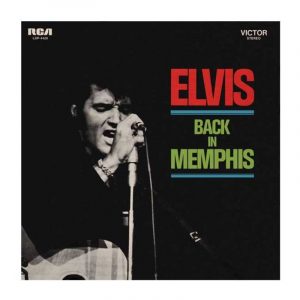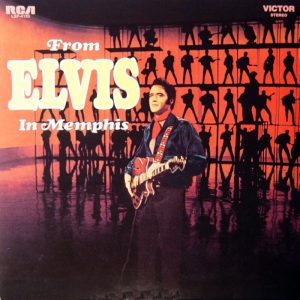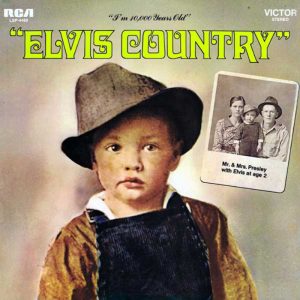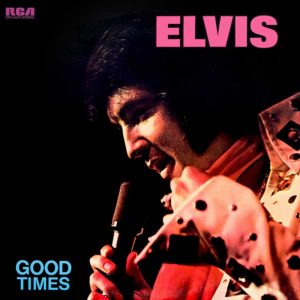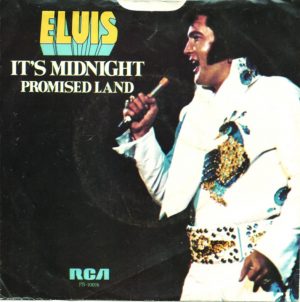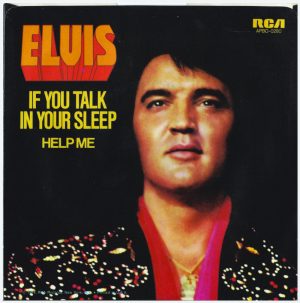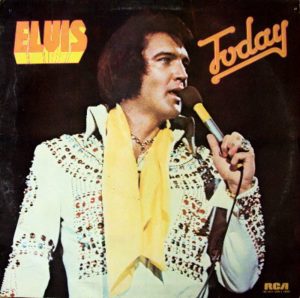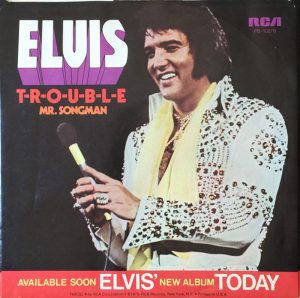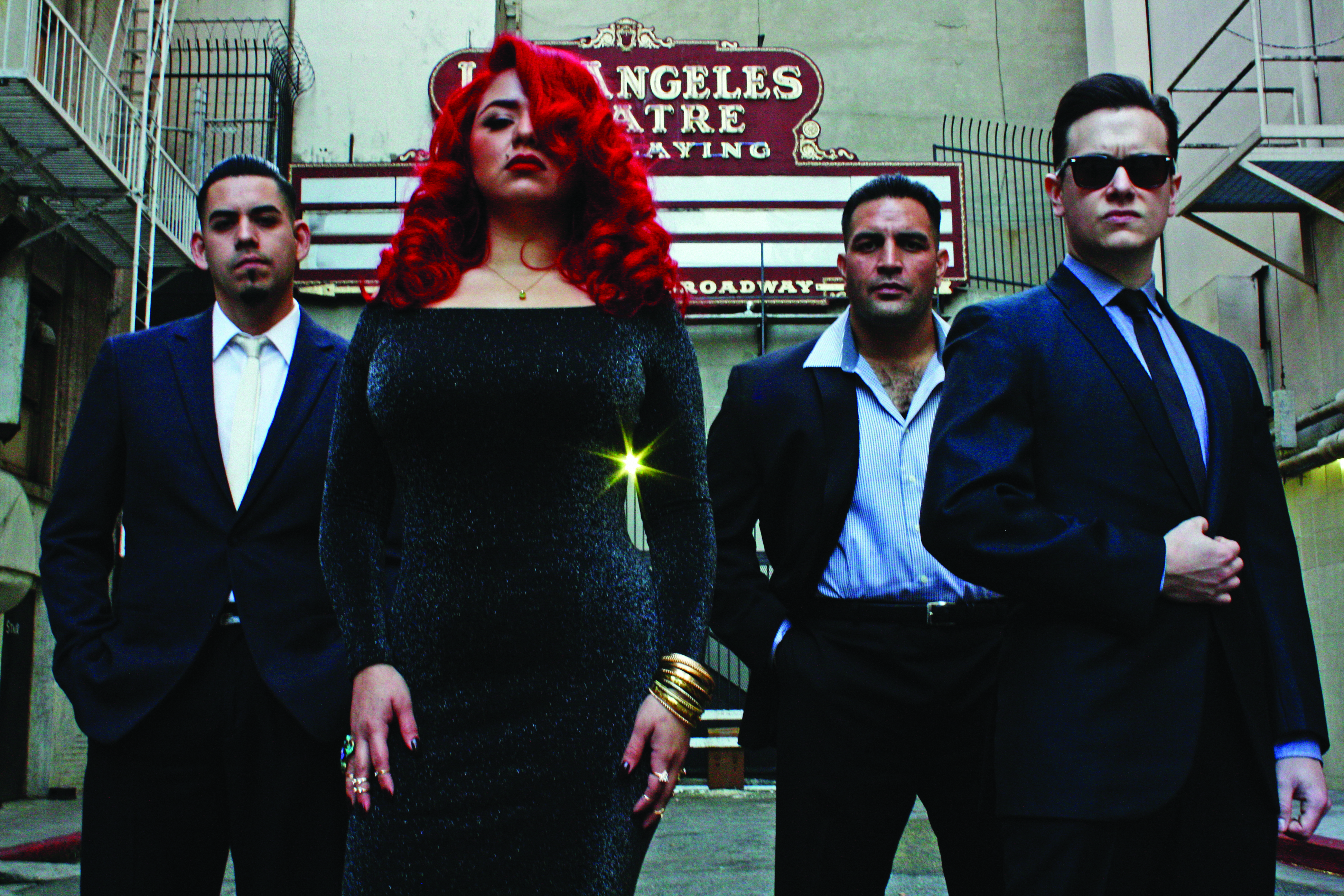Beyond the No.1 hits, Vintage Rock discovers some true gems in Elvis’ remarkable recorded catalogue in our Top 40 Lesser-Known Elvis Tracks…
Probably more so than with any other artist in music history, there exist several wildly different grades of Elvis fan, from one extreme – the legions of Presley obsessives who know every alternate take inside out and have all the studio banter down pat – to the other, casual music lovers who know and enjoy those timeworn greatest hits. Oh, and literally everyone in between.
Luckily, though, amongst Elvis’ momentous back catalogue there’s quite literally – as his 1961 LP denotes – Something For Everybody. So, in this chronological rundown of some of the items that, for whatever reason, haven’t quite received the attention they deserve, we’ve attempted to encapsulate Presley’s entire career as best we can, from early steps to closing statements. In doing so, we hope to serve up a musical palette that appeases the many layers that make up the musical mille-feuille of Presley fandom.
Treasure Trove
Survey what’s on offer and a treasure trove of untapped material quickly reveals itself, from B-sides and movie songs to the should-have-been classics that somehow passed the world by… and, in short, there’s far, far too much to choose from. We could literally make an entire magazine’s worth of lists, and then some. So instead, here we attempt to shed light on some of our personal favourite lesser-spun gems from the collection, those relics that we feel deserve a little more time on our record decks.
The dyed-in-the-wool Elvis fan will, no doubt, be familiar with many (if not all) of the tracks mentioned here, but this is intended as an open guide. For the casuals, it’s a playlist of new material to drink in at their leisure, and for those serious diehards with anything and everything, it’s a chance to revisit tracks that perhaps haven’t had a spin in a wee while.
From his early, hopeful demo through his rockabilly years at Sun, from his first steps with RCA, to his experimentations with country and gospel and on to the funk that rekindled his fire, we give you 40 of the finest unsung moments from Presley’s repertoire… and please do let us know which tracks made your personal rundowns.
Words Rik Flynn
Vintage Rock’s Top 40 Lesser Known Elvis Tracks
THAT’S WHEN YOUR HEARTACHES BEGIN
Record Label Sun/Demo Recorded 1953
If not for the first lowly demo recorded by Elvis with his beaten-up guitar at Sun Studios on Union Avenue, we may all have missed out. Aged just 18, Presley rocked up to the Memphis Recording Service to cut a double-sided acetate as a birthday gift for his mother. It cost just less than $4, and while this crackling, naive three minutes may be the polar opposite to the glossy summits of his later years, it’s a thing of spellbinding beauty that highlights the potential Sam Phillips clearly observed in the young lad that summer’s day. Elvis rolled it out at the infamous Million Dollar Quartet sessions in 1956 and re-recorded it with rich vocal backing and some slender orchestration the following year, transformed for the flipside to All Shook Up.
HARBOR LIGHTS
Record Label Sun/Unissued Recorded 1954
While at Sun, Elvis recorded a few early items that remain criminally overlooked, one of which is this gentle swaying melody first imagined by an Irishman and an England-living Austrian – Jimmy Kennedy and Hugh Williams (real name Wilhelm Grosz). The story is that Kennedy was lost driving around the south coast of England and happened upon a pub called Harbour Lights that inspired mournful memories of “tender nights beside the silvery sea”. Mistily romantic yet eerily moving, a 19-year old Elvis emotes the simple, mesmeric lead line before tracking the sea shanty-esque guitar licks with a plaintive whistle. Many won’t have heard it, but Harbor Lights was the first commercial recording made by Elvis. It can be found opening Sony’s Elvis At Sun compilation.
I’M LEFT, YOU’RE RIGHT, SHE’S GONE
Record Label RCA/Recorded 1955
With Arthur Gunter’s blues classic Baby Let’s Play House as the main attraction, Stanley Kesler and Bill Taylor penned this flipside to Elvis’ fourth single, supposedly inspired by a Campbell’s soup jingle. Cut at Sun in late 1954, this sturdy waxing reveals a startling performance from the young Hillbilly Cat, but it’s nothing without the Blue Moon Boys. D.J. Fontana (drums), Scotty Moore (guitar) and Bill Black (bass) who add their share of the magic by engineering this straight-up country ditty into something far more indispensable. A sluggish bluesy version exists, also laid down at Sun (entitled simply My Baby’s Gone), but it’s little more than a curious (somewhat inferior) listen. RCA reissued the original waxing in 1955.
TRYING TO GET TO YOU
Record Label RCA/Recorded 1954
Originally cut by doo-wop outfit The Eagles in 1954, this peppy side was laid down at Sun in the same fruitful July 1955 session that yielded Mystery Train and I Forgot To Remember To Forget, but was shelved until RCA bought out Elvis’ contract, whereupon it was unveiled on his first eponymous album. It was a tune much loved by Elvis and while he closely apes the original’s ice-cool intonation here, he also adds his own unmistakable rock’n’roll slant. Released as a single in August 1956, it was performed live on many occasions including, of course, that killer reworking for the ’68 TV Special. Fact fans: It’s Memphis drummer Johnny Bernero, not DJ Fontana who spars with Scotty Moore to exhilarating effect here.
MY BABY LEFT ME
Record Label RCA/Recorded 1956
This was the second item recorded by Elvis that came from the pen of Delta bluesman Arthur Crudup, the first, of course, being his 1954 breakthrough Sun Records single That’s All Right. Elvis was in no mood to slow things down having rocked his debut national television appearance on The Dorsey Brothers Stage Show and he continued directly on into RCA’s New York studio two days later for this, his opening session for new corporate stable, RCA. These Big Apple sessions produced several big numbers, notably Elvis’ hit take on Carl Perkins’ Blue Suede Shoes, and this infectious rocker. Despite the shiny production values, Elvis was once again in full control of affairs, demanding nine takes before he was happy. As usual, Bill, DJ and Scotty were right in the pocket.
WHEN MY BLUE MOON TURNS TO GOLD AGAIN
Record Label RCA/Recorded 1956
This much-covered country standard was written by songwriting partners Gene Sullivan and the superbly-named Wiley Walker and released by the duo (as ‘Wiley and Gene’) in 1941 on Okeh. Dreamt up by Sullivan whilst driving across Texas to Oklahoma under the light of a full moon, their dual-harmony, steel-flecked outing found some regional success, but was shifted up a gear by Elvis and crew, whose vivacious pop remake offers up only half of the original lyrics. The King can be seen decked out in glittery waistcoat cracking jokes before firing into a spirited version on The Ed Sullivan Show, backed by The Jordanaires. The song made the Top 20 as part of the Elvis – Volume 1 EP, and was also recorded by Hank Snow, Cindy Walker and Eddy Arnold, amongst others.
PARALYZED
Record Label RCA/Recorded 1956
All reports suggest that it was Elvis himself, not the RCA men, that ran the almost entirely unrehearsed Hollywood recording session that brought forth this quirky pop-rocker. Having handpicked his song choices from a pile of demos, Elvis got down to business. Paralyzed came from talented Brooklynite Otis Blackwell, one of Elvis’ go-to songwriters, but was never released as a single in the US. “The story I got was that, because of the word ‘paralyzed’ a lot of organisations got down on the thing, so they wouldn’t release it as a single,” Blackwell remembered to Jan-Erik Kjeseth. The song does however feature on the flip to his Elvis EP that hit No.59 and it reached the UK Top 10. It also features on the Elvis album.
ANYPLACE IS PARADISE
Record Label RCA/Recorded 1956
Recorded on 2 September 1956 with his usual intrepid cast of the Blue Moon Boys and the Jordanaires, this track formed part of Elvis’ inaugural sessions at Radio Recorders in Hollywood, a studio he would return to frequently in years to come. From the pen of New Orleans jazzer Joe ‘Cornbread’ Thomas, the track is taken into a fresh arena thanks to Moore’s pioneering riffery, a vibrant piano (supposedly from Jordanaire Gordon Stoker) and, of course, Elvis’ vocal cool. 1956 was an stratospheric year for the young Memphisian. January brought immediate regional success, and international fame had arrived by the close of the year thanks to numerous packed-out shows, plentiful (lucrative) TV slots and a debut film role in Love Me Tender. Anyplace Is Paradise features on Elvis, his second million-seller of the year.
SO GLAD YOU’RE MINE
Record Label RCA/Recorded 1956
Cut in that same hallowed New York session that turned out Blue Suede Shoes, this simplistic, vibrant rock’n’roller helped acclimatise the world to the more mainstream ambitions of Presley’s RCA tenure – even though the intention was likely to try and recreate his bare-bones Sun sound. The unprocessed, visceral blues of the South had played a huge part in the forging of Elvis’ early sound and this cut was another to come from ‘Big Boy’ Crudup, who’d provided Elvis with My Baby Left Me (eventual flipside to I Want You, I Need You, I Love You), plus his earth-trembling debut Sun 45, laid down earlier that year. Note yet another masterclass from guitarist Scotty Moore, who underpins this underplayed gem of the ’50s.
YOUNG AND BEAUTIFUL
Record Label RCA/Recorded 1957
Taken from Elvis’ first MGM film Jailhouse Rock and released on an EP of the same name, this soothing croon is a work of simmering wonder committed to tape in April 1957. Gifted New Yorkers Abner Silver and Aaron Schroeder were the men behind the magic, and Schroeder, in particular, would go on to pen a long list of Presley numbers including A Big Hunk o’ Love, Stuck On You and It’s Now Or Never. This stunning showstopper appears in the closing scene of the film – doubly poignant as Presley’s co-star Judy Tyler was tragically killed (with her husband) in a car crash shortly after the movie was completed. The event that saddened Presley so much that he reportedly couldn’t bear to watch the finished product.
I NEED YOU SO
Record Label RCA/Recorded 1957
In 1950, ‘Baron Of The Boogie’ Ivory Joe Hunter remained at the summit of the R&B charts for two weeks with this, his own rousing creation. Hunter was a hugely prolific songwriter – he is said to have written over 7000 songs – and Elvis clearly held his work in high regard. In fact, Ivory Joe was invited to Graceland shortly after the recording of this song, where the pair spent the day swapping stories and singing together. “He is very spiritually-minded,” said Joe of his host. “He showed me every courtesy, and I think he’s one of the greatest.” Hunter provided several tunes for the King including My Wish Came True(supposedly unveiled during that Graceland visit) and Ain’t That Lovin’ You, Baby. Both tracks were Top 20 singles for Elvis in the Sixties.
I GOT STUNG
Record Label RCA/Recorded 1958
First issued as a snappy counterpoint to the far more melodramatic One Night, this radiant rock’n’roller is two minutes of pure refined energy that has since gone A.W.O.L. Another finespun creation to come from Aaron Schroeder – and occasional partner David Hill (real name Hess), himself the source of a few other minor Elvis numbers – I Got Stung was laid down during one last two-day sojourn to Nashville before Presley departed the US for army duty in Germany. This double A-sided waxing peaked at No.4 in the US, but managed the top spot in the UK twice, when it became the UK’s 1000th No.1 single with its second release in 2005. Even so, One Night seems to have stolen the thunder from its lesser-heard companion.
A FOOL SUCH AS I
Record Label RCA/Recorded 1958
Recorded at the same June RCA studio session sneaked in before that stint in the army, Elvis laid down (Now And Then) A Fool Such As I together with A Big Hunk o’ Love, I Need Your Love Tonight, Ain’t That Loving You Baby and the aforementioned I Got Stung. Bill Trader’s song had already found chart success via two entirely different versions – one, a straight up country-style imagining from Hank Snow and the other, a polite yet brassy take from Jo Stafford issued in 1953. Elvis pushed the tempo north a little and rocked it up some for his delicious version, made with the Jordanaires a few years later. The track was consigned to the flipside of I Need Your Love Tonight, but became the bigger hit of the two, finding the No.2 spot in the US and No.1 in the UK.
IT FEELS SO RIGHT
Record Label RCA/Recorded 1960
A killer rock’n’blues groove underpins this slow-burning gem, this time made without Bill Black; he had left the group over disputes about payment after his final sessions in February, 1958. Cut in RCA’s Studio B with The Jordanaires in fine, rhythmic fettle, It Feels So Right first featured on Elvis’ post-Army comeback LP, Elvis Is Back! Elvis also performs the track in the cafe scene for 1965 movie Tickle Me, ‘strumming’ an acoustic guitar in a truly unconvincing mime. The track was later used for the underside to love-croon Easy Question and featured on the Pot Luck LP. The song’s writers, Wise and Weisman, also penned a fair few other Elvis movie songs including Crawfish, As Long As I Have You (both from King Creole) and Pocketful Of Rainbows (from G.I. Blues).
A MESS OF BLUES
Record Label RCA/Recorded 1960
Written by Brooklynites and eventual regular Presley songwriters Doc Pomus and Mort Shuman, A Mess Of Blues was the second attempt they’d delivered to the star, having received a firm rebuttal for their first offering Turn Me Loose (a later hit for Fabian). The atmosphere is electric on this willowy groover with The Jordanaires providing some of the finest backing of their career including a killer “hoo-hoo” hook that mimics the whistle of the train in the lyrics. Released as the flip to It’s Now Or Never in July 1960 (and itself a No.32 hit), the record went on to sell a million. Pomus and Shuman would go on to offer up a whole swathe of tracks for Presley with various different co-writers including Viva Las Vegas, written by Pomus with Norman Meade.
SUMMER KISSES, WINTER TEARS
Record Label RCA/Recorded 1960
This forlorn piece of Western balladry showcases the incredible heights Elvis’ voice could achieve. Taken from the Flaming Star movie, the song was intended for Elvis’ co-star Barbara Eden, but instead was ill-advisedly moved to a scene involving a peace pipe and some Native Americans. When the audience at a preview belly-laughed at this rather ridiculous spectacle, the song was removed entirely. Elvis was set upon being a serious actor, and his performance as mixed-race character Pacer Burton is often cited as one of his best. “He was a natural on a horse,” said Eden of her co-star. “He was really good at it, as he was at acting. I think Elvis, like a lot of country entertainers, had his feet mired in emotional truth. When they say something, it’s right up front.”
WORKING ON A BUILDING
Record Label RCA/Recorded 1960
Elvis had a seemingly endless store of religious songs in his repertoire, but this is surely one of his finest. Recorded during the two-day stint that made up His Hand In Mine, the first of Presley’s gospel LPs, Working On A Building encapsulates everything the archetypal Southern gospel tune should be. First mention of the song (as I Work On A Building Too) came in 1929, and music historian Wayne Erbsen noted “an almost calypso feel” (despite its proposed origins in Georgia) that’s certainly tangible in Elvis’ version. The Carter Family cut the song in 1932, followed by bluegrass icon Bill Monroe, whose 1954 duet with Jimmy Martin was likely heard by Elvis. It was also a favourite of BB King. His Hand In Mine went on to shift over a million copies.
RECONSIDER BABY
Record Label RCA/Recorded 1960
This solid gold blues standard emanated from the creative mind of West Coast blues torchman Lowell Fulson, who delivered his Checker original back in 1954, eloquently backed by some nicely-tempered brass and his own occasional guitar outbursts. It takes a brave soul to cross into territory such as this, but Elvis was up to the job, albeit in a notably different style. While his version maintains that swing-time feel so important to the song’s potency, much of that rambling guitar work is uprooted in favour of elevating his reverb-happy lead vocal as the obvious centrepiece. Still, a solo does arrive midway through in the welcome form of a blustery Boots Randolph sax break. One of the high points on the Elvis Is Back! LP.
THRILL OF YOUR LOVE
Record Label RCA/Recorded 1960
Recorded in April 1960 and brought to the world via Elvis Is Back!, this setting sun piece of classic Elvis balladry is raised up via some neat vocal work from the Jordanaires and an impassioned lead that revealed Elvis had lost none of his magnetic charm while in the army. Occasional Elvis contributor Stan Kesler wrote five tunes for the King, and this handsome slow-step was one of the best. An earlier waxing was issued in 1958 by Carl McVoy (Jerry Lee Lewis’ cousin), then titled A Woman’s Love, but with Elvis’ caramel tones behind the mic, McVoy’s take pales into relative insignificance. The lyrics’ juxtapositioning of wealth with love seemed all too fitting for a man who’d recently met his future wife while stationed in Germany.
THERE’S ALWAYS ME
Record Label RCA/Recorded 1961
Recorded in Nashville in March 1961, this touching rendition of Don Robertson’s simplistic ballad is notable for its powerful crescendo. Elvis recorded many of Robertson’s creations including I’m Counting On You from his debut LP. In fact, Elvis took the songwriter to his house to hear his version of this track prior to release. “He was very proud of his semi-operatic delivery of the title line at the end,” remembered Don, “as well he should have been.” The track features on the Something For Everybody LP and was released as an RCA single in 1967, but perhaps the most awe-inspiring interpretation arrived on 2015’s If I Can Dream: Elvis Presley With The Royal Philharmonic Orchestra – incomparable to the original, but still stunning.
SUSPICION
Record Label RCA/Recorded 1961
A highlight of the Pot Luck LP, this jaunty number from the catalogue of Elvis’ go-to songwriters Mort Shuman and Doc Pomus revolves around a rolling piano hook before making way for a brooding chorus that chimes in to dramatic effect. Elvis copycat Terry Stafford had a US Top 10 hit with an almost blueprint version in 1964, prompting RCA to try its luck in the charts with the Elvis version. Sadly for all concerned, Elvis’ infinitely superior take didn’t even manage to make the Billboard Top 100, but its novelty pop flip Kiss Me Quick – another (lesser) Shuman/Pomus composition – fared much better at No.38. It also made several Top 10 placements in Europe and even slipped into the UK Top 10 when recalled by RCA in 1976.
I NEED SOMEBODY TO LEAN ON
Record Label RCA/Recorded 1963
Taken from the soundtrack to MGM movie Leaving Las Vegas and initially released on the 1964 Viva Las Vegas EP, this lounge-room tearjerker is a perfect illustration of Presley’s incredible versatility. This slow-step was first recorded at Radio Recorders in Hollywood in July of 1963, while the movie version was laid down at the MGM sound stage later in September. While there’s no doubt this dreamy lament melted hearts in the stalls of movie theatres the world over, listen a little closer and behind Elvis’ velvet tones lies a fragile sincerity that for once let slip the man behind the mask. It was written by Pomus and Shuman, who wrote a total of 15 tracks for Presley including million-seller Little Sister, and were the team behind A Teenager In Love for Dion and the Belmonts.
IT HURTS ME
Record Label RCA/Recorded 1964
First issued as a single in 1964, the Studio B session that produced It Hurts Me – recorded alongside Memphis, Tennessee and Ask Me – marked the final Elvis session before the onslaught of movie soundtracks that completely hijacked his studio time right up until 1966. “Elvis came to town. He picked it up and held it for almost a year in what was called his portfolio,” remembered co-songwriter Charlie Daniels. “They’d pick songs out for Elvis and when he’d go in to record, he’d review them, and if he liked it, he’d do it. So anyway, he recorded it, and it was by far the biggest thing that had ever happened to me in my life.” As was bound to be the case, the song was installed as a B-side to a movie song, Kissin’ Cousins.
C’MON EVERYBODY
Record Label RCA/Recorded 1963
Taken from the Viva Las Vegas film and featuring on a four-track EP of the same name, this buoyant frivolity was penned by Joy Byers, the unlikely songwriter behind many of Elvis’ film songs throughout the Sixties. “It’s a thrill to have had a bunch of songs recorded by Elvis,” she told Ken Sharp. “I was a Fifties housewife, and next thing you know I’m writing songs for Elvis Presley. I was just thrilled.” The gym scene in Viva Las Vegas that features this song made No.30 in Rolling Stone’s ’Greatest Rock’n’Roll Movie Movements’ thanks to plentiful hip-shaking from Elvis and co-star Ann-Margret. The songs from four of Elvis’ films – Viva Las Vegas, Follow That Dream, Easy Come, Easy Go and Kid Galahad – were released together on the C’Mon Everybody compilation album in 1966.
(IT’S A) LONG LONELY HIGHWAY
Record Label RCA/Recorded 1963
Another tune expertly fashioned by hit-makers Pomus and Shuman, this sprightly rocker was aided and abetted by Nashville’s A-team (including prodigious guitarist Grady Martin). Elvis went into RCA Studio B in late May of 1963 with the intention of recording a brand new LP, set to feature tracks such as Devil In Disguise, Memphis, Tennessee and Witchcraft, but the album never materialised. Instead, the proceeds were drip-fed to the outside world over the next few years in various forms, with some ending up on film soundtracks. Long Lonely Highway featured on the soundtrack to 1964’s Kissin’ Cousins, in which Elvis plays the parts of two lookalike cousins. The film was a success and the soundtrack sold well too, peaking at No.6. It was certified gold in 1992.
TELL ME WHY
Record Label RCA/Recorded 1957
East Coast blues talent Titus Turner’s lush rhythm and blues ballad was first brought to the wider world’s attention via gospel/R&B singer Marie Knight’s passionate version, released on Wing in 1956. Knight found strong regional success with the track and Elvis had no doubt enjoyed her priceless rendition, choosing to cut his own, far smoother take at Radio Recorders in early 1957. However, for whatever reason, this dreamy rendering didn’t surface until almost nine years later, when it managed the lower echelons of the Billboard Top 40. A wonderfully undulating vocal intensity sets this apart from many of Elvis’ other slower numbers, meaning the doo-wop backdrop and economical instrumentation merely support the main event.
TOMORROW IS A LONG TIME
Record Label RCA/Recorded 1966
With that familiar tenor tremor, a little reverb and a bucketful of soul, this recording is supposedly Bob Dylan’s favourite version of his song. He once declared it “the one recording I treasure the most”, and who can blame him, with the depth of emotion on display in Presley’s compelling delivery? Dylan first cut the tune as a demo in 1962 and it first properly appeared on one of his greatest hits collections. It was then sessioneer Charlie McCoy who supposedly brought the track to Presley’s attention, via US folk singer Odetta’s Odetta Sings Dylan LP, aired prior to a session. Suitably charmed by the song, Elvis then took it on in May 1966 as part of his gospel LP How Great Thou Art, although it eventually ended up on the Spinout movie soundtrack.
LOVE LETTERS
Record Label RCA/Recorded 1966
Recently revived to widescreen with the help of the Royal Philharmonic Orchestra for their recent The Wonder Of You LP, this awe-inspiring ballad was first cut during the How Great Thou Art sessions. Written in 1945 by Edward Heyman and Victor Young (who wrote the popular classic When I Fall In Love), the song was nominated for a Best Song Grammy in the same year, but it wasn’t until almost a decade later that it was issued as a single for Elvis. A breathtakingly emotive turn from the King, backed with tempered piano-led orchestration, this gentle ballad managed to claw its way into the Billboard Top 20, but went Top 10 in the UK. It was later re-recorded and included on the 1970 LP Love Letters From Elvis.
GUITAR MAN
Record Label RCA/Recorded 1967
Elvis heard Jerry Reed’s Guitar Man on the wireless and immediately decided to record it. With the intended producer, Wrecking Crew member Billy Strange, sidelined when the dates were altered – and with RCA man Felton Jarvis back at the controls – the September 1967 Nashville sessions began, but when they were unable to reproduce the driving country sound that had so charmed Elvis on the original, Jerry Reed was called in to conduct the band. “As soon as we hit the intro, you could see Elvis’ eyes light up,” said Reed. “He knew we had it.” It was a productive session. Both the eventual flipside, the harmonica-infused Tommy Tucker song Hi Heel Sneakers and Big Boss Man (with Reed on guitar) are worthy additions to this list.
INDESCRIBABLY BLUE
Record Label RCA/Recorded 1966
Recorded June 12, 1966, during the Nashville sessions that spawned Elvis’ gospel opus How Great Thou Art, this delicate production was released as underside to Fools Fall In Love, a Lieber and Stoller song that was a hit for The Drifters in 1957. It’s a simple song that finds Presley in fine form. His haunting lead takes centre stage, while some neat Latin-style guitar magnifies the melancholia. The Jordanaires were this time joined by a Christian vocal outfit, The Imperials Quartet, who had sung on the gospel tracks. The group even went on to back Elvis in Vegas when The Jordanaires refused the job. Indescribably Blue only managed No.33 on the Billboard chart; still, it was Elvis’ biggest hit that year, just missing the Top 20.
THAT’S SOMEONE YOU NEVER FORGET
Record Label RCA/Recorded 1961
For those that were unaware, Elvis did occasionally try his hand at songwriting in the Sixties, and this silky slow-step is one such venture – a brooding ballad of the highest order co-written with close friend Red West (albeit only the title was provided by Elvis). West had learned guitar from Scotty Moore while a driver for Elvis and the Blue Moon Boys, and quickly progressed to songwriting. “That song had a strange, weird melody,” remembered West. “I like the way Elvis recorded all the songs that I wrote.” Elvis’ tender, emotive vibrato makes for about as absorbing a performance as is possible to get, and it’s a crying shame that he didn’t further pursue his own songwriting talents some more; this is one of his most beautiful tunes.
THIS IS THE STORY
Record Label RCA/Recorded 1969
Recorded as part of the now fabled 1969 American Sound Studio sessions that saw Elvis return to record in Memphis for the first time since leaving Sun in 1955, This Is The Story is worth a listen if only for the chiming, otherworldly guitar hook. Riding high after the resounding success of his TV special, Elvis is on top form in this, one of two recorded on the first day in that modest studio. From a simple beginning the track builds slowly, closing with a huge crescendo in which the choir of female backing singers add a soaring gospel denouement. These hallowed sessions birthed four classic hit singles – In the Ghetto, Suspicious Minds, Don’t Cry, Daddy and Kentucky Rain. This Is The Story features on the Back In Memphis album.
LONG BLACK LIMOUSINE
Record Label RCA/Recorded 1969
The first track recorded from those all-night homecoming sessions, this simmering tearjerker offered up a fresh sound for the King, whose vocal presence was the strongest it had been in years. Elvis was joined by producer Chips Moman; Moman, who it seems was fearless in the company of greatness. “When I told him he was off pitch,” he said to Mojo’s Barney Hoskyns, “his whole entourage would nearly faint.” Country musicians Vern Stovall and Bobby George’s songwriting success story was written at the close of the 50s and was first cut by Vern himself in 1961. From there, several other big names tried their hand including Glen Campbell, Rose Maddox and Merle Haggard, before Elvis handpicked the song for his grand return, the From Elvis In Memphis LP.
WEARIN’ THAT LOVED ON LOOK
Record Label RCA/Recorded 1969
Leading up to 1969, a slew of poor songs and bland, humdrum movies had ground Presley down: it was time for a shake-up. Infidelity is the subject and funk is the medium through which Elvis found his feet here on the second day of the American Sound Studio session. Penned by Nashville’s finest songwriters, Dallas Frazier and A.L. ‘Doodle’ Owens, this is pure class – in no small part thanks to the supremely-talented ‘Memphis Boys’ session band of Bobby Wood, Gene Chrisman, Mike Leech, Bobby Emmons, Tommy Cogbill and Reggie Young. From Young’s twanging electric guitar work through to the Wood’s groovesome piano lines, they show their mettle, lifting this lesser-heard morsel to ambrosial status.
I WASHED MY HANDS IN MUDDY WATER
Record Label RCA/Recorded 1970
Despite the impressive Memphis sessions, it was decided that Elvis should return to RCA’s Nashville studios – and their producer Felton Jarvis – to lay down his follow up to From Elvis In Memphis. Four days into that session, country music took the lead and it was soon decided that an unexpected country LP was on the cards. Here, he took Cowboy Joe Babcock’s honky tonk wonder and fired it up something proper. The song was included on the Elvis Country (I’m 10,000 Years Old) LP, an oft-ignored treasure trove that made No.12 and sold over a million at the time. Two far more reserved versions of the track preceded Elvis’ supercharged take: Stonewall Jackson cut the track in 1965, and Johnny Rivers had a hit with it in 1966.
GOOD TIME CHARLIE’S GOT THE BLUES
Record Label RCA/Recorded 1973
Danny O’Keefe wrote and released his mournful original (for the third time) in 1972 to great acclaim – and a Top 10 placement – and Elvis must have rather admired it, as he left the arrangement almost entirely untouched… aside from his telling omission of the line “I got my pills to ease the pain/ Can’t find a thing to ease the rain”. This reflective lament clearly suited the recently-divorced Elvis’ tendency to choose melancholy – often autobiographical – tracks in the Seventies and he certainly seems to relate to the lyrics here in what is a truly poignant take. Cut in December 1973 at Stax Memphis studios, Good Time Charlie’s Got The Blues made up part of the Good Times album and has been recorded by everyone from Jerry Lee Lewis to Conway Twitty.
PROMISED LAND
Record Label RCA/Recorded 1973
Elvis was a big fan of Chuck Berry and recorded several of his songs. Having taken on Too Much Monkey Business a few years earlier for the mish-mash LP that was Elvis Sings Flaming Star in 1968, he chose to give this famous rock’n’roller a fresh treatment at Stax in 1973 – sessions that included rock, country, pop, gospel and rhythm and blues. Elvis omitted an entire verse, as he was often prone to do, but the performance comes on like a steam train. Promised Land was the only Berry track that Elvis chose as a single and while both Chuck and Elvis landed at No.14 in the Billboard chart, Elvis stayed there for almost twice as long. Berry’s popularity plunged as the Seventies took hold, while Elvis’ Stax sessions also signalled a decline.
IF YOU TALK IN YOUR SLEEP
Record Label RCA/Recorded 1973
Laid down at those legendary Stax sessions (his final serious studio session), this mid-tempo funk track was co-written by Elvis confidante Red West. West went from being Elvis’ driver in the mid-Fifties to taking up a post as bodyguard when Elvis returned from the army. Several cameos in film followed, as did some stunt man work in films, but West’s songwriting talent came to the fore, writing items for Ricky Nelson, Pat Boone and Petula Clark as well as Elvis. Very much of its time, If You Talk In Your Sleep utilises a dynamic horn arrangement and some subtle electric guitar. It was a clear departure from Elvis’ Seventies comfort zone of countrified rock, and is perhaps a pointer as to what may have come in the future had he survived.
SUSAN WHEN SHE TRIED
Record Label RCA/Recorded 1975
With words and music provided by original Statler Brother Don Reid, this perky side centres around a strong vocal and some dextrous guitar picking from James Burton. The sessions that made up Presley’s Today LP took place at RCA’s Sunset Boulevard Studios in March, 1975; Susan When She Tried was laid down on the second day. His then-girlfriend Sheila Ryan accompanied the star to the studios and it took just six takes to nail this upbeat country toe-tapper, an excellent couple of minutes for those unfamiliar with Elvis’ C&W material. Elvis was 40 years old, and these sessions would be amongst his last. The rousing harmonies of the Statler Brothers original is also well worth a spin – even though they did take their name from a brand of tissues!
T-R-O-U-B-L-E
Record Label RCA/Recorded 1975
Not to be confused with his 1958 cut Trouble, this stoic rocker is another from the Today LP. It was written by Jerry Chestnut for (and about) rock’n’roll pianist Little David Wilkins, and Elvis knew he had a hit; the message came back from Graceland that he thought it was a “rock standard” and not to play it to another soul. After four run-throughs, Elvis had it in the bag: “He had done four or five of my songs already and I thought, ‘Here I’ve got a single by him coming out. This is the greatest thing you could have happen,’” said Chestnut. Jerry received one of the very last TCB insignia necklaces given by Elvis to anyone; around a month later, he was gone. The 45 was rush-released as the album’s opening single and reached the US Top 40.
For more on Elvis visit the official website here
Enjoy This Article? Checkout The Vintage Rock Top 101 Rockabilly Tracks


